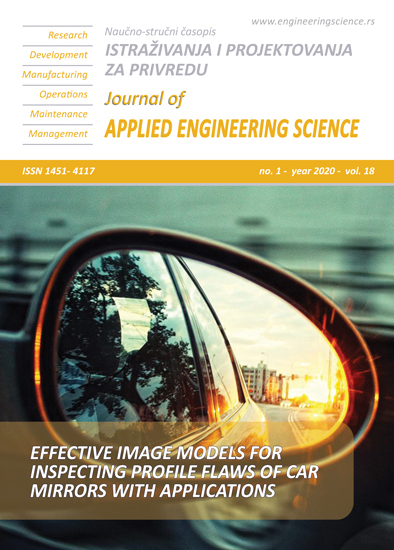DEVELOPMENT STRATEGIES AND TRANSFORMATION OF THE REGION’S INDUSTRIAL COMPLEX
Abstract
The aim of the study is to analyze the industrial complex transformation of the provincial region and determine the prospects for its development. The economic potential of industrial complex of the Mari El Republic of Russia is analyzed. The structural and dynamic analysis of the region’s manufacturing industry, as well as the analysis of its material and technical base, investment, innovation and human resources is carried out. High depreciation of fixed assets of industry prevents its successful transformation. The high impact of the investment level on the growth rate of the manufacturing industry has been revealed. The low level of region’s innovative potential has no impact on the manufacturing industry development. The personnel potential of the region's industry is characterized by the outflow of personnel with higher education and the availability of personnel with labour occupations.
The development strategies of the region’s industrial complex are considered. High-tech enterprises of the region (IT-sphere, enterprises for the electrical equipment production, electronic and optical equipment production) can implement an offensive strategy of innovative development. The intermediate strategy and import substitution strategy are substantiated as actual strategic decisions for the enterprises of medium and low-tech industry sectors. They can provide competitive positions of the region's industry.
References
/1/ Government Regulation of the Russian Federation of April 15, 2014 No. 328 “On approval of the state program of the Russian Federation “The development of industry and increase its competitiveness”, from https://base.garant.ru/70643464/, accessed on 2019-04-20.
/2/ Presidential Decree of May 9, 2017 No. 203 “On the Strategy for the Information Society Development in the Russian Federation for 2017–2030”, from https://www.garant.ru/products/ipo/prime/doc/71570570/, accessed on 2019-04-20.
/3/ Plan of measures (“road map”) of “Technet” (advanced production technologies) of the National Technology Initiative, from https://asi.ru/upload/iblock/4b2/DK_TechNet.pdf, accessed on 2019-04-20.
/4/ Kolosovsky, N.N. (1969). The theory of economic zoning. Thought, Moscow
/5/ Yakovets, Yu.V. (2011). Global Economic Transformations of the XXI Century. Ekonomika, Moscow
/6/ Trachuk, A.V., Linder, N.V. & Tarasov, I.V. (2018). The transformation of industry in the fourth industrial revolution. Trachuk A.V. (Ed.), Publishing House “Real Economy”, St. Petersburg.
/7/ Prebisch, R. (1988). Dependence, development, and interdependence. Schultz, T. P., Ranis, G. (Eds.), The state of development economics: Progress and Perspectives. John Wiley and Sons Ltd, Oxford, p. 31-48.
/8/ Perroux, F. (2017). The pole of development's new place in a general theory of economic activity. Edited by Benjamin Higgins, B., Savoie, Donald J. (Eds.), Regional Economic Development: Essays in Honour of Francois Perroux. Routledge, p. 48-76.
/9/ Rostow, W.W. (1985). The World Economy since 1945: A Stylized Historical Analysis. The Economic History Review, vol. 38, no 2, 252-275.
/10/ Mensch, G. (1979). Stalematein Technology: Innovations Overcome the Depression. Cambridge, Massachusetts
/11/ Sapir, J. (2005). Diversity of trajectories and the path effect: Post-Soviet transitions [Diversité des trajectoires et effet de sentier: Les transitions post-Soviétiques]. Revue d'Etudes Comparatives Est-Ouest, vol. 36, no 2, 177-208.
/12/ Kemp, R. (2011). Innovation for sustainable development as a topic for environmental assessment. Journal of Industrial Ecology, vol. 15, no 5, 673-675.
/13/ Hegyi-Kéri, A. (2013). Regional Specialization and Geographic Concentration of Economic Sectors in the Visegrád Countries. Club of Economics in Miskolc, TMP, vol. 9, no 1, 31-41.
/14/ Vujosevic, M., Petovar, K. (2010). European planning discource and a renewal of European sustainable development planning: some lessons for a transition country (Serbia). Sociology and Space, vol. 48, no 2(187), 173-195.
/15/ Sarra, A., Di Berardino, C., Quaglione, D. (2019). Deindustrialization and the technological intensity of manufacturing subsystems in the European Union. Economia Politica, vol. 36, no 1, 205-243, DOI:10.1007/s40888-018-0112-8.
/16/ Beg, M., Sertic, M.B., Druzic, I. (2017). Determinants of deindustrialisation in developed European and post-communist countries. Montenegrin Journal of Economics, vol. 13, no 2, 93-106.
/17/ Lošonc, A., Ivanišević, A. (2014). Deindustrialization: Why would anyone it is a myth. International Journal of Industrial Engineering and Management, vol. 5, no 1, 29-38.
/18/ Tomljanović, M., Grubišić, Z., & Huđek, I. (2018). Process of Deindustrialization in Montenegro. Journal of Central Banking Theory and Practice, vol. 7, no 2, 99-121, DOI:10.2478/jcbtp-2018-0014.
/19/ Glaziev, S. Yu. (1993). Theory of long-term technical and economic development. VlaDar, Moscow.
/20/ Polterovich, V.M. (2007). Elements of Reform Theory. Ekonomika, Moscow
/21/ Kleiner, G.B. (2017). System transformation of industry as a “solid core” of the domestic economy. Scientific Works of the Free Economic Society of Russia, vol. 207, no 5, 210-223.
/22/ Sukharev, O.S. (2018). Estimation of the level of industrialization of regional economy and regional industrial policy. Economic Policy and Resource Potential of the Region. p. 152-163.
/23/ Maslikhina, V. Yu. (2017). Spatial concentration of the manufacturing industry: Evidence from Russia. Journal of Applied Engineering Science. vol. 15, no 4, 509-517, DOI:10.5937/jaes15-14961.
/24/ Rosstat. Regions of Russia. Social and Economic Indicators – 2018, from http://www.gks.ru/, accessed on 2019-05-20.
/25/ Maristat, from http://maristat.gks.ru/wps/wcm/connect/rosstat_ts/maristat/ru/, accessed on 2019-05-20.
/26/ AIRR. Ranking of Innovative Regions of Russia, from http://i-regions.org/eng/ratings/rating-of-innovation-development, accessed on 2019-05-24.
/27/ Adamaytis, S. et al. (2019). National report “High-tech business in the Russian regions”. Zemtsov S. (Ed.), issue 2, RANEPA, AIRR, Moscow
/28/ Akberdina, V., Kalinina, A., & Vlasov, A. (2018). Transformation stages of the Russian industrial complex in the context of economy digitization. Problems and Perspectives in Management, vol. 16, no. 4, 201-211.
/29/ Tsvetkova, G. S., Murtazina, A. S., Grozova, O. S. (2019). Theoretical and methodological aspects of the study of key competences of the region. Vestnik of Volga State University of Technology. Series “Economy and Management”, no 1 (41). 30-39, DOI: 10.25686 / 2306-2800.2019.1.30.
/30/ Freeman, Ch., Soete, L. (1997). The Economics for Industrial Innovation. MIT Press, Cambridge
/31/ Lambin, J. J. (2000). Market-driven management: Strategic and operational marketing. Basingstoke (Hants), Macmillan press, London

